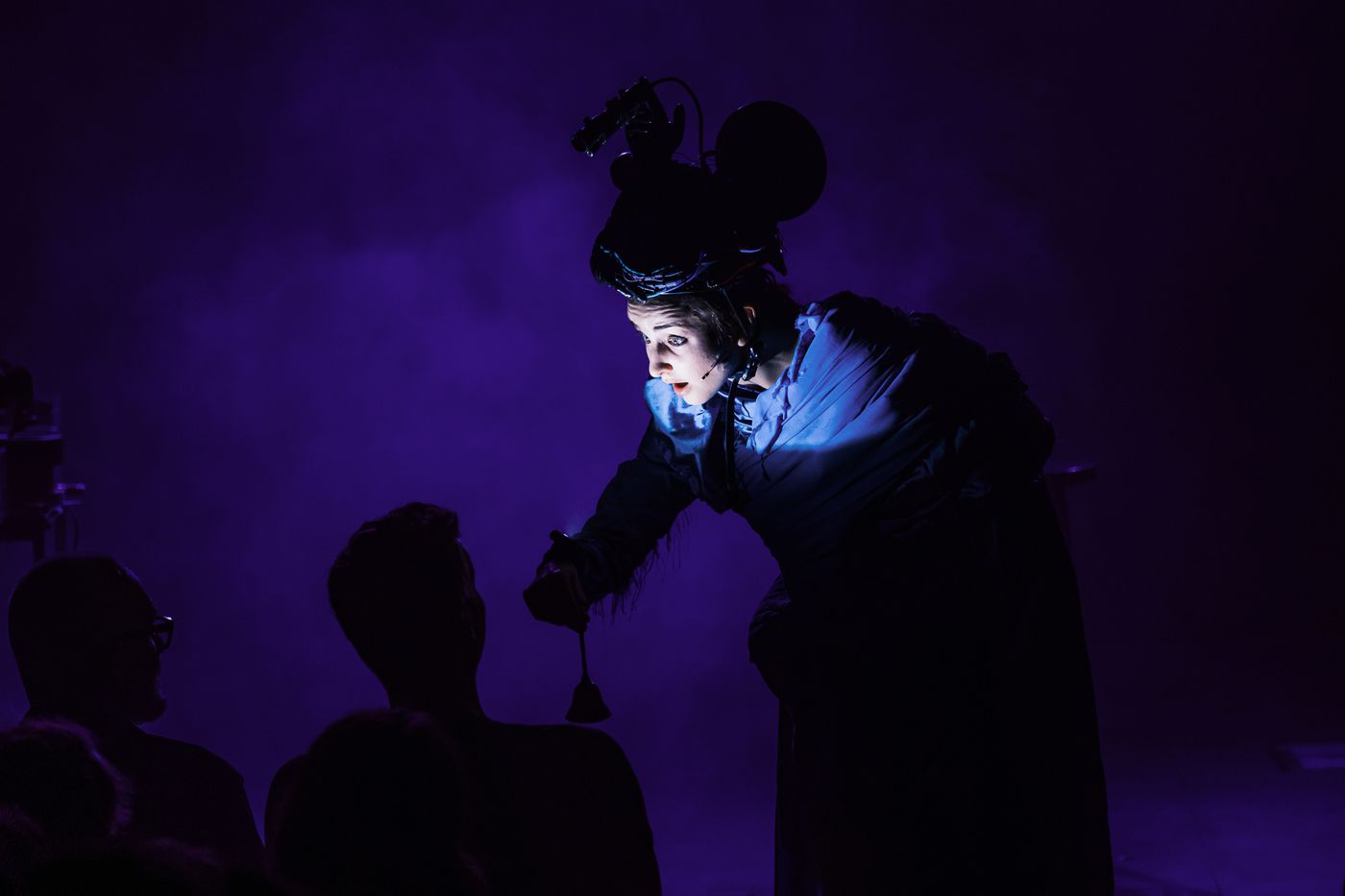
Spotting David Byrne in the wild is one thing, but I was not prepared to see an antennaed clown shriek at him and smash his wooden chair when he hesitantly cawed back. Nor did I expect the clown to guide the 72-year-old musician onstage, where he dutifully got on his knees and hammered the chair shards back together. Goggles on, he labored for almost an hour as she crept up to baffled strangers with a microphone, taped to a mannequin leg slung over her arm. Some assisted with rebuilding. Others, following orders, crowd-surfed, gave metaphorical birth to themselves, and wrote down solutions to climate change on the wall. “Shut up!” the clown snapped playfully at Byrne when his pounding became too disruptive.
This mayhem erupted at the SoHo Playhouse, which the Estonian artist Julia Masli is taking over for three-and-a-half weeks with her show Ha ha ha ha ha ha ha. (That’s seven ha’s, to be exact.) It was the talk of the town at the 2023 Edinburgh Festival Fringe, where it was nominated for Best Comedy Show; I’d heard about it from a British friend who raved after seeing it in London a few months ago. Each night, Masli surfaces from fog like a storybook sorceress, bundled in fabric with a pointy wire-covered hat that beams light. She waits. Her wide blue eyes dart mischievously, like she’s both beholding her earthly surroundings for the first time and harboring the universe’s secrets. It’s with this combination of wonder and mystique that she then approaches her audience, moving down the aisle and mewing, “Problem?”

The resulting hour is an answer to the thought experiment “What if Amelia Bedelia were a therapist?” One night, a man in the audience said he was tired, so Masli brought out a chaise longue onstage and invited him to doze off — blindfolded, for extra-quality sleep. Two strangers confessed to being lonely, so she moved them next to each other and duct-taped them together. But not all of the answers are trivial or make for easy comedy; audience members grieve their dead pets, their inability to support their financially struggling families. Masli, by nature an empathetic person, responds with compassion. Her shows also facilitate a kind of mutual aid. One audience member said she was thirsty, and a seconds later a barrage of canned beers, water bottles, and half-drunk cocktails came flying her way.
How did Ha ha ha ha ha ha ha come to be?
It started with the title. I was going to Edinburgh to do my first solo show, Choosh, about an Eastern European migrant who travels to America for a hot dog. I was thinking, What am I gonna do after Choosh is over? So I just messaged my friend Kate who ran the Bill Murray Comedy Club in London to book a new show. And I said, “I have a title.” She asked for the blurb. And I was like, it’s “Ha ha ha ha he he he ho ho …” just blurting it out. She put it on sale. Then I came back from Edinburgh and I was like, Oh no.
I started doing research and got obsessed with healers. I was curious about clowning and what the purpose of it was early on, like there’s a healing element to the archetype of the trickster. So it grew from there. The “problem?” thing just kind of happened — I tried that and people gave so much back to the suggestion. I didn’t realize that was going to be the skeleton of the show.
What was your upbringing like? How did you arrive at the art of clowning?
I grew up in Estonia. I always liked walking around in my dad’s trousers or wearing tights on my head. I loved putting on shows for my family and friends. Then I moved to the U.K. when I was 12. I still couldn’t really speak English properly, so I fell into doing physical theater, being cast in nonverbal roles in school plays. I discovered Complicité, a theater company based in England that does a poetic form of clowning with a lot of literary texts. I was wowed. I did a workshop with them and they told me about École Philippe Gaulier in France. A lot of people in my class were stand-up comedians, so I just fell into doing comedy by chance — even though I wanted to do serious theater.
How would you describe your experience training at École Philippe Gaulier?
It was very hard. Gaulier bangs the drum and he says, “You are so boring. You’re a piece of shit.” But it’s with love. And then everyone is laughing. There’s a horrible exercise where you have to go onstage and pretend to be a washing machine. I’ve never seen anyone succeed.
I wanted to do really well. I remember making a costume all night and thinking, When I got to the stage it would make everyone die with laughter. And then no one did. I just stood there, and burst into tears when I sat down. I remember someone telling me, “If only you cried onstage, then we would love you.”
I read that you didn’t make anyone laugh for nine weeks.
Yeah, I couldn’t for ages, and it really broke my ego down. I think giving up was such an important thing for me. The next day, I had a big breakthrough.
What was it?
I had to be a plumber. That’s it. I had to make people laugh. I looked at the pipes in the ceiling and just said, “Oh God.” And then everybody laughed for some reason, and I remember being so shocked after so many months of no laughter. Then they started to laugh because I was so shocked. Then I started crying with joy. They started to laugh because I was crying with joy. They were laughing at the stupidity of me being so amazed by the laughter, and that’s the human aspect I was hiding before.

I could imagine, for someone who came from Estonia and had a hard time communicating with your peers, that that kind of laughter could be traumatic. What made you want to be laughed at?
It’s true, because in stand-up you have control. They’re laughing with you. With clowning, they’re laughing at you. But it’s liberating. The laughter isn’t mean. They still love you. There’s something nice about being loved. By embracing failure, clowns allow us to accept that we’re imperfect as humans, and I think that’s what I connect to so much.
This trauma of trying to fit in — I think clowning allows you to reclaim that. I have more of an accent in the show than when I did when I arrived in the U.K. It’s nice.
Tell me about the character you’re playing onstage. You’re wearing an antenna, and … is that a bedsheet you’ve wrapped around yourself?
You could say that. There’s a pillow attached to my shoulder for people to share their problems. There’s a hand holding wires on my helmet, because there’s a lot going on in my head. I remember during Choosh putting a leg on my arm and becoming this creature, but my dramaturge at the time said it didn’t fit. So I put it to bed and then brought it back.
But yeah, the clown is an exaggeration and its intention is quite pure. I trust myself to respond when people share something really vulnerable with me because I know that the clown has good intentions. I like connecting with people and have had problems in the past with poor boundaries, but it’s nice with the show, because I feel very protected.
How did you react to seeing David Byrne at your show?
Honestly, I didn’t realize it was him until afterward. I’m a fan of Talking Heads, but I just didn’t know what he looks like now. I picked him completely by chance. He left the chair, and it’s a really beautiful piece of sculpture that he made. No one has made one quite like that in the show.

Have there been any other surprise appearances?
In London, I had an incredible guest — Brian Eno. I’m a big fan of his music. So that was crazy.
Did you pick him?
I did not. I only found out afterward.
Sometimes the problems you receive are pretty silly. And sometimes they’re really serious — like on Monday, there was a trans person in the audience who admitted to feeling anguished by their own voice. Are there moments you feel unequipped to respond?
I definitely feel that. I’m really lucky I work with an amazing performance artist, Kim Noble. He always says, “You don’t have to always go for laughter. Just be with them. And if you don’t know how to respond, just be honest.” Everyone has been fine, because they’re adults, and people also take care of each other.
One beautiful person shared on the first night here that they were sad that their dad will never meet their baby because he died. They were tearing up. I definitely felt like, Whoa. And then in that show, I asked other people if they had lost someone, and the person on the other side of the aisle said he lost his brother. And then they looked at each other and really connected.
What have been your favorite silly moments from the show?
There are so many. Someone wasn’t sure if they switched off their oven, and their dog was still in the house. Everyone got them to leave the show to check the oven. Someone was colorblind, and they weren’t sure about the outfit they picked. Everyone in the audience said that it was a great outfit. Someone else said they have a lovely roommate who helps them coordinate colors. So we called the roommate, and the person said, “Thank you so much for doing that.”
Has the reception in New York been different than in London?
I was telling someone that this is the perfect place for this show because people are warmer and more open. I’ve never experienced a situation where people are already whooping and cheering when I come onstage.
Clowning seems to be breaking into the mainstream — several clowning acts have won top prizes at the Fringe, like Natalie Palamides’s Nate, which got its own Netflix special in 2020. Who do you consider your peers and inspirations?
I really love Natalie. She definitely inspired me. In L.A., there’s a whole clown community doing incredible, interesting work. In London too. I’m also inspired by experimental theater, like Kim Noble inspired me hugely with his show Lullaby for Scavengers. Lucia Hopkins is very punk and curates her own spaces.
Going forward, are there things that you’d like to explore? What’s next for you?
I love to one day try clowning with a live orchestra. Classical music is so epic, and clowning is the opposite. I’ve always dreamed of performing tragedy — generally, I really like watching the things that make me cry, more than watching comedy, which I’m just discovering now in a way. I love this Swedish director called Roy Anderson, and Emir Kusturica who made one of my favorite films, Time of the Gypsies. I’m interested in seeing how clowning can translate to film or video.
Related
- People Fear Clowns for the Same Reason They Fear Uncertainty
- Oh Look, Here’s All My Exes Hanging Out Together
Cat Zhang , 2024-05-27 16:00:32
Source link


